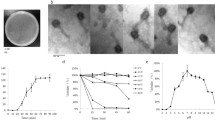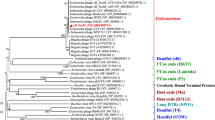Abstract
During a study of the genetic diversity of Stenotrophomonas strains, we found an autonomous replicating DNA molecule in chromosomal DNA preparations of the clinical Stenotrophomonas maltophilia strain c5. The entire sequence of 6,907 bp of the isolated DNA molecule was determined, which was called φSMA9. Seven ORFs, which code for proteins with considerable similarity to proteins in databases, were identified in the DNA sequence. The largest ORF shows high sequence similarities to the pI protein of the filamentous phage φLf, which was later shown to be identical to toxin Zot of Vibrio cholerae. Beside the Zot-like protein, six other proteins with similarities to known phage proteins such as a phage replication protein RstA and phage absorption or coat protein are encoded on φSMA9, which indicate that this circular DNA molecule represents the replicative form of a linear phage genome. A PCR-based screening showed that only five from the totally investigated 47 Stenotrophomonas strains of clinical and environmental origin harbor these genes. Altogether, we describe the first genome of a phage for the nosocomial pathogen Stenotrophomonas, which contains a Zot toxin like gene and might be regarded as the first Stenotrophomonas virulence factor.





Similar content being viewed by others
References
Alonso A, Martinez JL (1997) Multiple resistances in Stenotrophomonas maltophilia. Antimicrob Agents Chemother 41:140–1142
Alonso A, Morales G, Escalante R, Campanario E, Sastre L, Martinez JL (2004) Overexpression of the multidrug efflux pump SmeDEF impairs Stenotrophomonas maltophilia physiology. J Antimicrob Chemother 53:432–434
Altschul SF, Madden TL, Schaffer AA, Zhang J, Zhang Z, Miller W, Lipman DJ (1997) Gapped BLAST and PSI-BLAST: a new generation of protein database search programs. Nucleic Acids Res 25:3389–3402
Anderson DG, McKay LL (1983) Simple and rapid method for isolating large plasmid DNA from Lactic Streptococci. Appl Environ Microbiol 46:549–559
Berg G, Knaape C, Ballin G, Seidel D (1994) Biological control of Verticillium dahliae KLEB by naturally occurring rhizosphere bacteria. Arch Phytopathol Dis Prot 29:249–262
Berg G, Marten P, Ballin G (1996) Stenotrophomonas maltophilia in the rhizosphere of oilseed rape—occurrence, characterization and interaction with phytopathogenic fungi. Microbiol Res 151:19–27
Berg G, Roskot N, Smalla K (1999) Genotypic and phenotypic relationships between clinical and environmental isolates of Stenotrophomonas maltophilia. J Clin Microbiol 37:3594–3600
Berg G, Eberl L, Hartmann A (2005) The rhizosphere as a reservoir for opportunistic human pathogenic bacteria. Environ Microbiol 7:1673–1685
Binks PR, Nicklin S, Bruce NC (1995) Degradation of RDX by Stenotrophomonas maltophilia PB1. Appl Environ Microbiol 61:1813–1322
Block A, Schmelz E, O’Donnell PJ, Jones JB, Klee HJ (2005). Systemic acquired tolerance to virulent bacterial pathogens in tomato. Plant Physiol 138:1481–1490
Chang K-H, Wen F-S, Tseng T-T, Lin N-T, Yang M-T, Tseng YH (1998) Sequence analysis and expression of the filamentous phage phi LF gene I encoding a 48-kDa protein associated with host cell membranes. Biochem Biophys Res Commun 245:313–318
Chang H-C, Chen C-R, Lin J-W, Shen G-H, Chang K-M, Tseng Y-H, Weng S-F (2005) Isolation and characterization of novel giant Stenotrophomonas phage φSMA5. Appl Environ Microbiol 71:1387–1393
Davis BM, Waldor MK (2003) Filamentous phages linked to virulence of Vibrio cholerae. Curr Opin Microbiol 6:35–42
Denton M, Kerr KG (1998) Microbiological and clinical aspects of infections associated with Stenotrophomonas maltophilia. Clin Microbiol Rev 11:7–80
De Abreu Vidipó L, De Andrade Marques E, Puchelle E, Plotkowski MC (2001) Stenotrophomonas maltophilia interaction with human epithelial respiratory cells in vitro. Microbiol Immumol 45:563–569
De Oliveira-Garcia D, Dall’Agnol M, Rosales M, Azzuz AC, Alcantaram N, Martinez MB, Giron JA (2003) Fimbriae and adherence of Stenotrophomonas maltophilia to epithelial cells and to abiotic surfaces. Cell Microbiol 5:625–636
Di Pierro M, Lu R, Uzzau S, Wang W, Margaretten K, Pazzani C, Maimone F, Fasano A (2001) Zonula occludens toxin structure-function analysis. J Biol Chem 276:19160–19166
Dunne C, Moënne-Loccoz Y, de Bruijn FJ, O´Gara F (2000) Overproduction of an inducile extracellular serine protease improves biological control of Pythium ultimum by Stenotrophomonas maltophilia strain W81. Microbiology 146:2069–2078
Fasano A, Baudry B, Pumplim DW, Wasserman SS, Tall BD, Ketley JM, Kaper JB (1991) Vibrio cholerae produces a second enterotoxin, which affects intestinal tight junctions. Proc Natl Acad Sci USA 88:5242–5246
Fasano A, Florentini C, Donelli G, Uzzau S, Kaper JB, Margaretten K, Ding X, Guandalini S, Comstock L, Goldblum SE (1995) Zonula occludens toxin modulates tight junctions through protein kinase C-dependent actin reorganization in vitro. J Clin Invest 96:710–720
Finkmann W, Altendorf K, Stackebrandt E, Lipski A (2000) Characterization of N2O-producing Xanthomonas-like isolates from biofilters as Stenotrophomonas nitritireducens sp. nov., Luteimonas mephitis gen. nov., sp. nov. and Pseudoxanthomonas broegbernensis gen. nov. sp. nov. Int J Syst Evol Microbiol 50:273–282
Gerner-Smidt P, Bruun B, Arpi M, Schmidt J (1995) Diversity of nosocomial Xanthomonas maltophilia (Stenotrophomonas maltophilia) as determined by ribotyping. Europ J Clin Microbiol Infect Dis 14:137–140
Hagemann M, Schoor A, Jeanjean R, Zuther E, Joset F (1997) The gene stpA from Synechocystis sp. strain PCC 6803 encodes for the glucosylglycerol-phosphate phosphatase involved in cyanobacterial salt adaptation. J Bacteriol 179:1717–1733
Heipern AJ, Waldor MK (2003) pIIICTX, a predicted CTXφ minor coat protein, can expand the host range of coliphage fd to include Vibrio cholerae. J Bacteriol 185:1037–1044
Huber KE, Waldor MK (2002) Filamentous phage integration requires the host recombinases XerC and XerD. Nature 417:656–659
Ikemoto S, Suzuki K, Kaneko T, Komagata K (1980) Characterization of strains of Pseudomonas maltophilia which do not require methionine. Int J Syst Bacteriol 30:437–447
Jacobi M, Kaiser D, Berg G, Jung G, Winkelmann G, Bahl H (1996) Maltophilin—a new antifungal compound produced by Stenotrophomomas maltophilia R3089. J Antib 49:1101–1104
Lin N-T, Liu T-J, Lee T-C, You B-Y, Yang M-H, Wen F-S, Tseng Y-H (1999) The adsorption protein genes of Xanthomonas campestris filamentous phages determining host specificity. J Bacteriol 181:2465–2471
Lin N-T, Chang R-Y, Lee S-J, Tseng Y-H (2001) Plasmids carrying cloned fragments of RF DNA from the filamentous phage φLF can be integrated into the host chromosome via site-specific integration and homologous recombination. Mol Genet Genomics 266:425–435
McKay GA, Woods DE, MacDonald KL, Poole K (2003) Role of phosphoglucomutase of Stenotrophomonas malttophilia in lipopolysaccharide biosynthesis, virulence and antibiotic resistance. Infect Immun 71:3068–3075
Minkwitz A, Berg G (2001) Comparison of antifungal activities and 16S ribosomal DNA sequences of clinical and environmental isolates of Stenotrophomonas maltophilia. J Clin Microbiol 39:139–145
Nakayama T, Homma Y, Hashidoko Y, Mitzutani J, Tahara S (1999) Possible role of xanthobaccins produced by Stenotrophomonas sp. strain SB-K88 in suppression of sugar beet damping-off disease. Appl Environ Microbiol 65:4334–4339
Palleroni NJ, Bradbury JF (1993) Stenotrophomonas, a new bacterial genus for Xanthomonas maltophilia (Hugh 1980) Swings et al. 1983. Int J Syst Bacteriol 43: 606–609
Rademaker JLW, De Bruijn FJ (1992) Characterization and classification of microbes by REP-PCR genomic fingerprinting and computer-assisted pattern analysis. In: Caetano-Anollés G, Gresshoff PM (eds) DNA markers: protocols, applications and overviews. Wiley, New York
Rivera IN, Chun J, Huo A, Sack RB, Colwell RR (2001) Genotypes associated with virulence in environmental isolates of Vibrio cholerae. Appl Environ Microbiol 67:2421–2429
Schaumann R, Stein K, Eckardt C, Ackermann G, Rodloff AC (2001) Infections caused by Stenotrophomonas maltophilia—a prospective study. Infection 4:205–209
Steinkamp G, Wiedemann B, Rietschel E, Krahl A, Gielen J, Barmeier H, Ratjen F (2005) Prospective evaluation of emerging bacteria in cystic fibrosis. J Cyst Fibros 4:41–48
Suckstorff I, Berg G (2003) Evidence for dose-dependent effects on plant growth by Stenotrophomonas strains from different origins. J Appl Microbiol 95:656–663
Wolf A, Fritze A, Hagemann M, Berg G (2002) Stenotrophomonas rhizophila sp. nov., a novel plant-associated bacterium with antifungal properties. Int J Syst Evol Microbiol 52:1937–1944
Yang HC, Im WT, Kang MS, Shin DY, Lee ST (2006) Stenotrophomonas koreensis sp. nov. isolated from compost in South Korea. Int J Syst Evol Microbiol 56:81–84
Acknowledgements
The work was supported by a grant of the DFG (Deutsche Forschungsgemeinschaft). Many thanks are to Dr. M. K. Walden, Tufts University, Boston, USA, for helpful discussion. We would like to thank the Sanger Institute and Wellcome Trust for making the S. maltophilia strain 279a genome sequence already available for the public.
Author information
Authors and Affiliations
Corresponding author
Rights and permissions
About this article
Cite this article
Hagemann, M., Hasse, D. & Berg, G. Detection of a Phage Genome Carrying a Zonula Occludens like Toxin Gene (zot) in clinical isolates of Stenotrophomonas maltophilia . Arch Microbiol 185, 449–458 (2006). https://doi.org/10.1007/s00203-006-0115-7
Received:
Revised:
Accepted:
Published:
Issue Date:
DOI: https://doi.org/10.1007/s00203-006-0115-7




